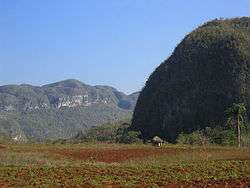Mogote

Dome-like rounded mogotes in Viñales Valley, Cuba.
Mogotes are generally isolated steep-sided residual hills, which are composed of either limestone, marble, or dolomite and surrounded by nearly flat alluvial plains. These hills typically have a rounded, tower-like form.
Overview
This term is used for hills, isolated or linked, with very steep - almost vertical walls- surrounded by alluvial plains, in the tropics regardless of whether the carbonate strata in which they have formed is folded or not.[1][2]
Gallery
 Puerto Rico Mogotes rising out of pineapple fields in a plain of blanket sand near Coto Sur. The quarry in the left background is 1 kilometer east of Manati.
Puerto Rico Mogotes rising out of pineapple fields in a plain of blanket sand near Coto Sur. The quarry in the left background is 1 kilometer east of Manati. Two mogotes showing they typical rounded shape growing up in Viñales Valleyin Pinar del Río Province, western Cuba
Two mogotes showing they typical rounded shape growing up in Viñales Valleyin Pinar del Río Province, western Cuba Mogotes, Northern Matanzas Province, near the city of Cárdenas, Cuba
Mogotes, Northern Matanzas Province, near the city of Cárdenas, Cuba- Mogotes in Northern Cuba, between Matanzas and Havana Provinces
References
- ↑ Neuendorf, K. K. E., J. P. Mehl, Jr., and J. A. Jackson, 2005, Glossary of Geology, 5th ed. American Geological Institute, Alexandria, Virginia. 779 p. ISBN 0-922152-76-4
- ↑ U.S. Environmental Protection Agency, 2002, A Lexicon of Cave and Karst Terminology with Special Reference to Environmental Karst Hydrology (2002 Edition). U.S. Environmental Protection Agency, Office of Research and Development, National Center for Environmental Assessment, Washington Office, Washington, D.C., EPA/600/R-02/003. 221 p.
- Day, M. J. (March 1978). "Morphology and distribution of residual limestone hills (mogotes) in the karst of northern Puerto Rico". Geological Society of America Bulletin. 89 (3): 426–32. doi:10.1130/0016-7606(1978)89<426:madorl>2.0.co;2.
External links
- (in Spanish) Mogote on wordreference.com
This article is issued from
Wikipedia.
The text is licensed under Creative Commons - Attribution - Sharealike.
Additional terms may apply for the media files.